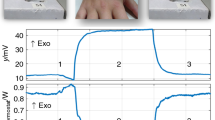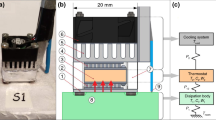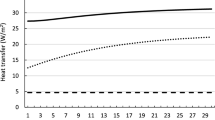Abstract
A calorimetric sensor for medical application has been developed to measure surface and localize heat dissipations of human body. The instrument evaluates the heat flux transmitted by conduction, through a thermopile, between the human body surface and a programmed thermostat at a set temperature. In this work, a model with twelve transfer functions describing the operation of the sensor is exposed. This model relates the inputs to outputs of the system. Sensitivities, poles and zeros of each of the transfer functions are obtained with two independent experimental measurements and a numerical optimization method based on the adjustment of the experimental output curves with the ones calculated by the model. The model simulates the operation of the sensor, determines its operating limits and assesses the flow of heat between human skin and the thermostat sensor. The proposed method is applicable to any non-differential calorimeter.









Similar content being viewed by others
References
Isalgue A, Ortin J, Torra V, Viñals J. Heat flux calorimeters: dynamical model localized time constants. An Fis. 1980;76:192–6.
Socorro F, de Rivera MR, Jesús C. A thermal model of a flow calorimeter. J Therm Anal Calorim. 2001;64:357–66.
Socorro F, de la Nuez I, Rodríguez de Rivera M. Calibration of isothermal heat conduction calorimeters: case of flow calorimeters. Measurement. 2003;33:241–50.
Kirchner R, de Rivera MR, Seidel JM, Torra V. Identification of micro-scale calorimetric devices. Part VI. An approach by RC-representative model to improvements in TAM microcalorimeters. J Therm Anal Calorim. 2005;82:179–84.
Rodríguez de Rivera M, Socorro F. Flow microcalorimetry and thermokinetics of liquid mixtures. J Therm Anal Calorim. 2007;87:591–4.
Socorro F, Rodríguez de Rivera M. Modellization of the mixture dissipation in a flow microcalorimeter. J Therm Anal Calorim. 2007;88:741–4.
Jesús C, Socorro F, Rodríguez de Rivera M. New approach to Tian’s equation applied to heat conduction and liquid injection calorimeters. J Therm Anal Calorim. 2012;110:1523–32.
Hansen LD. Toward a standard nomenclature for calorimetry. Thermochim Acta. 2001;371:19–22.
Wendlandt WW. Thermal methods of analysis. New York: Wiley; 1974.
Brown ME, editor. Handbook of thermal analysis and calorimetry: principles and practice, vol. 1. Amsterdam: Elsevier; 1998.
Lahiri BB, Bagavathiaappan S, Jayakumar T, Philip J. Medical applications of infrared thermography: a review. Infrared Phys Technol. 2012;55:221–35.
Livingston S, Nolan R, Frim J, Reed L, Limmer R. A thermographic study of the effect of body composition and ambient temperature on the accuracy of mean skin temperature calculations. Eur J Appl Physiol Occup Physiol. 1987;56:120–5.
Haidar SG, Charity RM, Bassi RS, Nicolai P, Singh BK. Knee skin temperature following uncomplicated total knee replacement. Knee. 2006;13:422–6.
Mehra A, Langkamer VG, Day A, Harris S, Spencer RF. Creative protein and skin temperature post total knee replacement. Knee. 2005;12:297–300.
Rajapakse C, Grennan DM, Jones C, Wilkinson L, Jayson M. Thermography in the assessment of peripheral joint inflammation—a re-evaluation. Rheumatol Rehabil. 1981;20:81–7.
Denoble AE, Hall N, Pieper CF, Kraus VB. Patellar skin surface temperature by thermography reflects knee osteoarthritis severity. Clin Med Insights Arthritis Musculosketet Disord. 2010;3:69–75.
Rokita E, Rok T, Taton G. Application of thermography for the assessment of allergen-induced skin reactions. Med Phys. 2011;38:765–72.
Vecchio PC, Adebajo AO, Chard MD, Thomas PP, Hazleman BL. Thermography of frozen sholder and rotator cuff tendinitis. Clin Rheumatol. 1992;11:382–4.
Miyakoshi N, Itoi E, Sato K, Suzuki K, Matsuura H. Skin temperature of the shoulder: circadian rhythms in normal and pathologic shoulders. J Shoulder Elb Surg. 1998;7:625–8.
Godoy SE, Hayat MM, Ramirez DA, Myers SA, Padilla RS, Krishna S. Detection theory for accurate and non-invasive skin cancer diagnosis using dynamic thermal imaging. Biomed Opt Express. 2017;8(4):2301–23.
Socorro F, Rodriguez de Rivera M. Development of a calorimetric sensor for medical application. Part I—operating model. J Therm Anal Calorim. 2010;99:799–802.
Jesús C, Socorro F, Rodríguez de Rivera M. Development of a calorimetric sensor for medical application. Part II. Identification and simulation. J Therm Anal Calorim. 2013;113:1003–7.
Jesús C, Socorro F, Rodríguez de Rivera M. Development of a calorimetric sensor for medical application. Part III. Operating methods and applications. J Therm Anal Calorim. 2013;113:1009–13.
Jesús C, Socorro F, Rodríguez de Rivera HJ, Rodríguez de Rivera M. Development of a calorimetric sensor for medical application. Part IV. Deconvolution of the calorimetric signal. J Therm Anal Calorim. 2014;116:151–5.
Socorro F, Rodriguez de Rivera PJ, Rodriguez de Rivera M. Calorimetric minisensor for the localized measurement of surface heat dissipated from the human body. Sensors. 2016;16:1864.
Socorro F, Rodríguez de Rivera PJ, Rodríguez de Rivera Mi, Rodríguez de Rivera M. Mathematical model for localised and surface heat flux of the human body obtained from measurements performed with a calorimetry minisensor. Sensors. 2017;17:2749.
Rodríguez de Rivera PJ, Rodríguez de Rivera Mi, Socorro F, Rodríguez de Rivera M. Method for transient heat flux determination in human body surface using a direct calorimetry sensor. Measurement. 2019;139:1–9.
Rodríguez de Rivera PJ, Rodríguez de Rivera Mi, Socorro F, Rodríguez de Rivera M. Measurement of human body surface heat flux using a calorimetric sensor. J Therm Biol. 2019;81:178–84.
Ogata K. Modern control engineering. Upper Saddle River: Prentice Hall; 2010.
Åström KJ, Hägglund T. Advanced PID control. Durham: Research Triangle Park, Instrumentation, Systems, and Automation Society; 2006.
Ziegler JG, Nichols NB. Optimum settings for automatic controllers. ASME Trans. 1942;64:759–68.
Ziegler JG, Nichols NB. Process lags in automatic control circuits. ASME Trans. 1943;65:433–44.
Lagarias JC, Reeds JA, Wright MH, Wright PE. Convergence properties of the Nelder–Mead simplex method in low dimensions. SIAM J Optim. 1998;9(1):112–47.
Nelder JA, Mead C. A simplex method for function minimization. Comput J. 1965;7:308–13.
Optimization ToolboxTM User’s Guide, 5th printing; Revised for Version 3.0 (Release 14); The MathWorks, Inc.: Natic, MA, USA, June 2004.
Funding
This work was completed while Pedro Jesús Rodríguez de Rivera was beneficiary of a pre-doctoral grant given by the “Ministerio de Ciencia, Innovación y Universidades (Spain)” and the “Agencia Canaria de Investigación, Innovación y Sociedad de la Información del Gobierno de Canarias (Spain)”.
Author information
Authors and Affiliations
Corresponding author
Additional information
Publisher's Note
Springer Nature remains neutral with regard to jurisdictional claims in published maps and institutional affiliations.
Rights and permissions
About this article
Cite this article
Rodríguez de Rivera, P.J., Rodríguez de Rivera, M., Socorro, F. et al. Modelling and simulation of the operation of a calorimetric sensor for medical application. J Therm Anal Calorim 142, 483–492 (2020). https://doi.org/10.1007/s10973-020-09554-6
Received:
Accepted:
Published:
Issue Date:
DOI: https://doi.org/10.1007/s10973-020-09554-6




